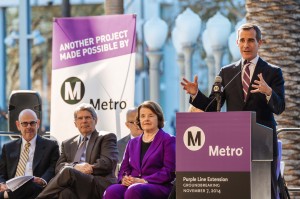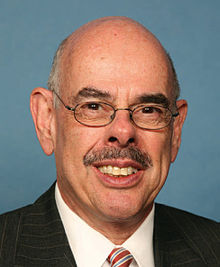 Former Representative Henry Waxman breaks down the options for the president’s final 18 months in office:
Former Representative Henry Waxman breaks down the options for the president’s final 18 months in office:
Executive authority, especially under the Clean Air Act, provides numerous paths for meaningful climate action. It can deliver popular, pro-growth, business-friendly pollution reductions that today are not possible through legislation. That is the legacy of one of our most important laws, and it can shape the legacy of this administration and the next.
Waxman goes on to list potential options to reduce emissions in aviation, cars and trucks, and other industrial sectors outside of electricity. It’s worth reading the whole thing.
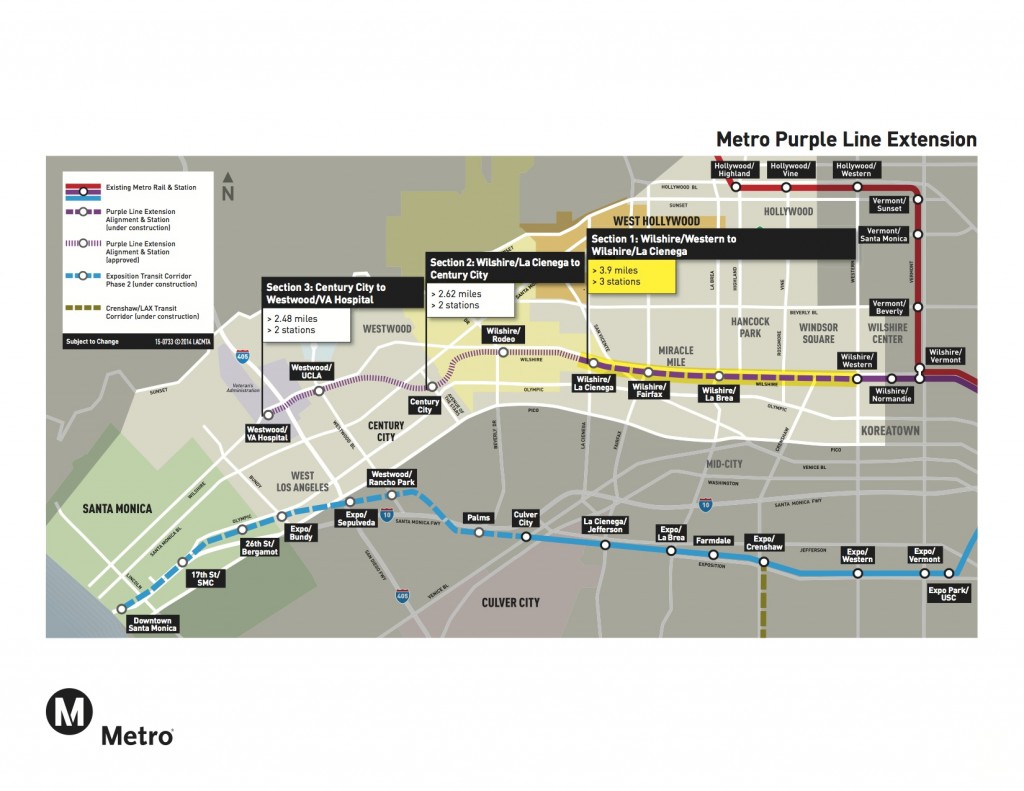 Well, that only took 30 years. Groundbreaking for the badly needed Wilshire Purple Line subway extension happened this morning. The new extension will run from the current terminus at Western along Wilshire Boulevard to La Cienega, with stops at La Break and Fairfax in between. I can’t overstate how important this project is for mobility in Los Angeles. It will serve as the transit backbone for the Westside and will provide a mobility option for the most densely populated corridor west of the Mississippi River.
Well, that only took 30 years. Groundbreaking for the badly needed Wilshire Purple Line subway extension happened this morning. The new extension will run from the current terminus at Western along Wilshire Boulevard to La Cienega, with stops at La Break and Fairfax in between. I can’t overstate how important this project is for mobility in Los Angeles. It will serve as the transit backbone for the Westside and will provide a mobility option for the most densely populated corridor west of the Mississippi River.
Of course, if Congressman Waxman hadn’t stopped the line back in the mid-1980s, the ceremony would be occurring today on Wilshire and Fairfax instead, and we’d be looking at an extension now into Century City. But oh well, no point in looking back. (Or we could just look at the photo of Waxman sitting next to the podium, celebrating an event that he tried to stop and then succeeded in delaying for decades.)
But in the meantime, this new 3.9-mile extension isn’t slated to open for almost a decade, in 2023. And these projects have a way of falling behind schedule. This after voters essentially approved the funding six years ago in 2008 with the passage of Measure R. So the delays involved are mind-boggling.
This timeline must be shortened. I hope rail advocates and elected officials step up the pressure to get this project completed in a few years and not decades. There’s simply no reason in this modern age why a 3.9-mile tunnel should take that long. We should have a thorough, transparent explanation for the construction timeline and a plan for how to overcome the challenges. Angelenos should know what they can do to move this project along.
So while there is a lot to celebrate today, there’s more work to be done to make sure this project gets built quickly, inexpensively, and in a manner that maintains the public’s trust.
If LA were only to build one rail line, it should have been down Wilshire Boulevard. The corridor represents the most densely populated route west of the Mississippi River. So of course it will take almost 30 years since ground was first broken for Metro Rail before it starts to really serve that area. Today the federal government and Metro announced a $1.25B federal grant and $856M loan for the Wilshire “Purple Line” subway extension to go 3.9 miles, from its current terminus at Western, to La Cienega (dotted purple line in the map below):
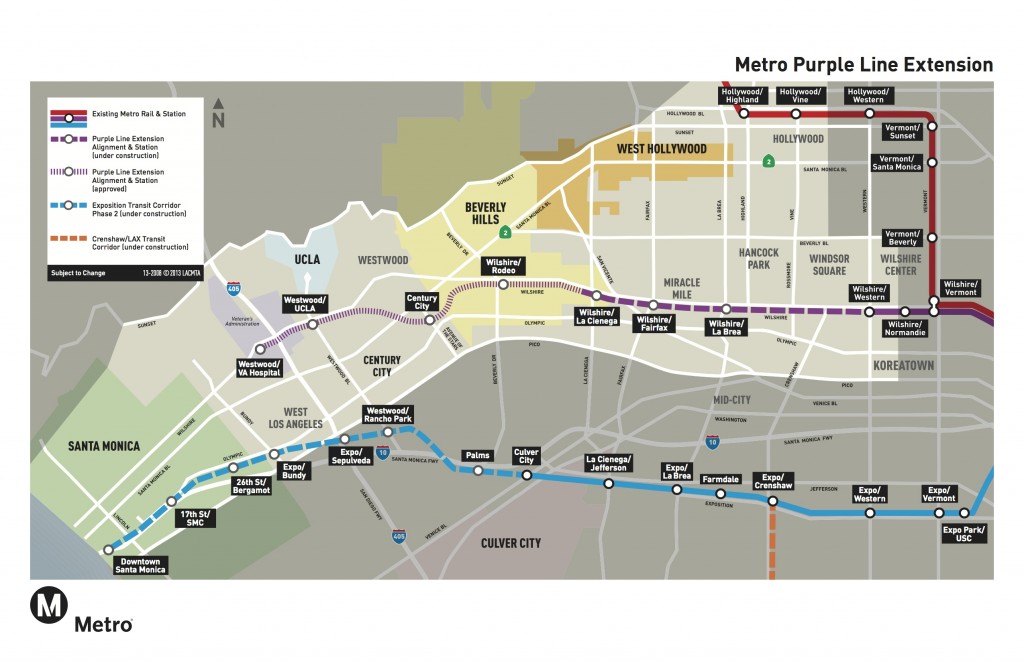
It’s worth celebrating this announcement, because it’s a long time coming. It took a ridiculous amount of time to get here, and it’s worth remembering the highlights of the long battle:
- 1964: The Southern California Rapid Transit District was formed in Los Angeles in part to raise money to build a subway down Wilshire.
- 1968: Sales tax ballot initiative to pay for LA rail fails.
- 1973: Tom Bradley elected mayor on a pro-subway platform, the centerpiece of his campaign.
- 1974: Bradley’s sales tax measure fails.
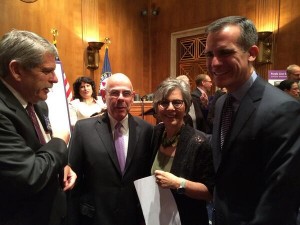
Rep. Waxman, not ashamed to take credit this morning for the project he tried to kill and effectively delayed two decades. Supervisor Yaroslavsky, also pictured, supported Waxman’s ban while on the city council at the time.
- 1976: Another sales tax measure fails, this time from Supervisor Baxter Ward. But the Ford Administration grants some money to LA to begin studying rail.
- 1980: Proposition A, which dedicates some new sales tax money for rail, passes.
- 1985: Methane gas explosion on Fairfax Avenue gives Rep. Waxman an excuse to kill the subway in his district, which includes the key parts of the Wilshire corridor.
- 1986: LA rail officials negotiate a compromise with Waxman to keep the subway alive but out of his district. A ban on tunneling down Wilshire past Western Avenue is now federal law. Groundbreaking is held on the first 4.1 mile segment.
- 1990: Another half-cent sales tax measure passes.
- 1993: The first subway segment opens.
- 2000: The final 18.6 miles of the subway opens to North Hollywood.
- 2007: After two decades of lobbying, local leaders (and fed-up constituents) finally convince Waxman to relent on his tunneling ban, which was never rooted in legitimate engineering concerns over safety.
- 2008: Over 2/3rds of Angelenos vote for a sales tax measure to fund more rail (and other transportation improvements). The “Subway to the Sea” is a big part of the selling.
- 2012: Move LA and other transit leaders convince the federal government to include a low-cost loan program for projects like rail in LA with a dedicated revenue source (the sales tax). $856M in loans will now help this phase of the subway get built.
My book Railtown chronicles this history in more depth, but this is a snapshot. Of course, it doesn’t convey the decades of frustration, traffic, and misery that the lack of rail on this corridor has caused. It also doesn’t fully credit all the people who have played their part to make the subway happen. But at least it provides a sense of how long it can take to get good public policy right and hopefully an appreciation for how long this moment was in the making.

